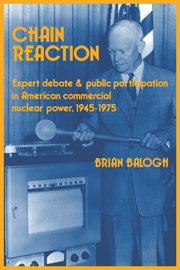 Chain Reaction
Chain Reaction Book contents
- Frontmatter
- Contents
- Acknowledgments
- List of abbreviations
- 1 From fission to fusion: professionalization and politics in twentieth-century America
- 2 The promise of the proministrative state: nuclear experts and national politics, 1945–1947
- 3 Forging an iron triangle: the politics of verisimilitude
- 4 Triangulating demand: the Atomic Energy Commission's first decade of commercialization
- 5 The centrifugal push of expertise: reactor safety, 1947–1960
- 6 The magnetic pull of professional disciplines, issue networks, and local government
- 7 Nuclear experts on top, not on tap: mainstreaming expertise, 1957–1970
- 8 Nuclear experts everywhere: the challenge to nuclear power, 1960–1975
- 9 Conclusion: harnessing political chain reactions
- Index
8 - Nuclear experts everywhere: the challenge to nuclear power, 1960–1975
Published online by Cambridge University Press: 07 May 2010
- Frontmatter
- Contents
- Acknowledgments
- List of abbreviations
- 1 From fission to fusion: professionalization and politics in twentieth-century America
- 2 The promise of the proministrative state: nuclear experts and national politics, 1945–1947
- 3 Forging an iron triangle: the politics of verisimilitude
- 4 Triangulating demand: the Atomic Energy Commission's first decade of commercialization
- 5 The centrifugal push of expertise: reactor safety, 1947–1960
- 6 The magnetic pull of professional disciplines, issue networks, and local government
- 7 Nuclear experts on top, not on tap: mainstreaming expertise, 1957–1970
- 8 Nuclear experts everywhere: the challenge to nuclear power, 1960–1975
- 9 Conclusion: harnessing political chain reactions
- Index
Summary
Nuclear power's enhanced visibility in the early sixties pushed into the limelight Atomic Energy Commission experts charged with ensuring and evaluating reactor safety. It also created record demands for their services. By 1970, thanks in part to the federal government's ongoing effort to produce more technical experts and in part to the AEC's organizational specialization, there were competing centers of safety expertise within the Atomic Energy Commission. The Advisory Committee on Reactor Safeguards – the dominant source of safety expertise in the fifties – jostled with several newly developed sources of safety expertise. The regulatory staff was one. The fledgling Hazards Evaluation Branch, which was the technical core of the Division of Licensing and Regulation (Regulatory Staff), had acquired more resources and higher stature during the early sixties. Commercialization also spawned another network of safety expertise dominated by the Atomic Energy Commission comprising the national laboratories (and their contractors) that tested through engineered experiments the theoretical calculations of the AEC's safety experts.
The proliferation of expertise and expanding number of organizations charged with safety review within the Atomic Energy Commission was part of the larger evolution that the nation's nuclear promoter hoped to complete, ultimately emerging as the nation's nuclear watchdog. As Glenn Seaborg pointed out to presidential science adviser Donald Hornig in September 1968, the AEC had scaled back its efforts to assure the economic success and reliability of light-water technology.
- Type
- Chapter
- Information
- Chain ReactionExpert Debate and Public Participation in American Commercial Nuclear Power 1945–1975, pp. 221 - 301Publisher: Cambridge University PressPrint publication year: 1991


